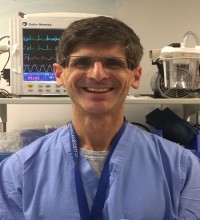contact
Jade Sutton
Administrative Assistant II
Management of the Airway and Emergencies of the Sedated Patient in Your Dental Office
| Tuition: | Dental Team $4,995 (Maximum of eight (8) participants per office)
Please contact our office for information regarding a larger number of participants. |
| Credits: |
2 CDE credit hours - lecture The University of Maryland School of Dentistry designated this activity for 6 Continuing Dental Education hours. |
| Target Audience: | Dental Team |
| Presented by: | Marvin Leventer, DDS |
| Conflict of Interest: | Nothing to disclose. |
Register Here
Speaker Biography
 Dr. Leventer received his dental degree from the University of Maryland in 1990. He then completed a General Practice Residency, and a Dental Anesthesiology Residency at Brookdale Hospital Medical Center in New York.
Dr. Leventer received his dental degree from the University of Maryland in 1990. He then completed a General Practice Residency, and a Dental Anesthesiology Residency at Brookdale Hospital Medical Center in New York.
Dr. Leventer is a Diplomat of the American Dental Board of Anesthesiology where he is also on the Board of Directors and serves as a board examiner. He is a member of the American Society of Dentist Anesthesiologists, the Academy of General Dentistry and the American Dental Association. Dr. Leventer is committed to providing dental care without pain or anxiety.
Dr. Leventer began his academic career in 1997 as a part time clinical instructor in Dental Anesthesiology at the University of Maryland School of Dentistry while maintaining a private general dental practice with a focus on anesthesia for dentistry. In 2009 he became a full time Clinical Assistant Professor at the University of Maryland School of Dentistry. He provides sedation and general anesthesia within the school of dentistry, practices general dentistry in the faculty practice and provides dental services at the University of Maryland Hospital. He has presented many CE courses on the topics of the use of sedation and anesthesia in dentistry.
Course Description
Are you and your team prepared if a medical emergency occurred during your patient’s dental procedure?
This course will be given in the providing dentist’s office with their staff. We will come to you and bring manikins, monitors, and practice medications to simulate sedation emergencies. During this course we will use a combination of your emergency resources and equipment along with the equipment we will bring.
This is a participatory course that will include a short didactic component, but largely focus on the management of common as well as rare events in the dental office. The participants will all have an opportunity to practice airway skills, oxygen administration, and administration of emergency drugs to the manikins during simulated emergencies.
This training will count toward a class 1, 2, or 3 sedation and general anesthesia permit renewal, and the requirement for a course in airway and emergencies. We follow an outline of the requirements to obtain a sedation/anesthesia permit in most states.
Our team is prepared to review either adult or pediatric emergencies.
Maximum registration is eight (8) participants per office.
Course Objectives
During this lecture participants will:
- List criteria in the primary assessment of the patient’s health status.
- List criteria in the secondary assessment of the patient’s health status.
- List ways to prepare your dental office environment and staff on management of emergencies
- Describe the use of standard vital signs monitors and how to interpret their data.
- List and demonstrate use of basic life support emergency medications and explain their pharmacologic action.
- List and demonstrate as appropriate, Advanced Cardiac Life Support (ACLS) emergency drugs and their pharmacologic action.
- List and demonstrate steps in proper airway assessment and how to manage a compromised airway.
- List and demonstrate use of emergency supplies and equipment and explain how to use them.
- Describe signs and symptoms and demonstrate management steps for the following dental office emergencies: Laryngospasm, foreign body airway obstruction, emesis, aspiration, allergic reaction, anaphylaxis, asthma, bronchospasm, angina, bradycardia, tachycardia, ventricular fibrillation, cardiac arrest, hypotension, hypertension, seizure, syncope, hypoxemia, apnea, airway/operatory fire, sedation and local anesthetic overdose, adrenal insufficiency, hyperglycemia, hypoglycemia.
- List and describe the necessary components of proper record keeping and demonstrate their use during emergencies.
